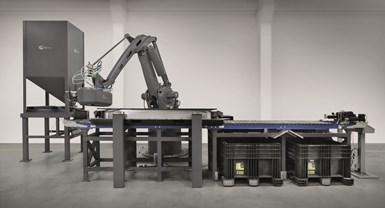Optimized Castings, Fast Turnarounds with Sand 3D Printing
IMTS 2022: ExOne’s S-Max Flex pairs industrial robots with an end effector printhead design that deposits binder into a 1,900 × 1,000 × 1,000 mm (74 × 39 × 39") telescoping build box that grows as the parts are built layer by layer.
3D printing sandcasting molds and cores straight from CAD files enables foundries to eliminate the months-long lead times and high costs of traditional patterns and core boxes. The design freedom of additive manufacturing (AM) also enables designers to develop parts made with the reliable casting process — creating complex, consolidated geometries that enable lightweighting and optimized part performance not possible with traditional processes.
The S-Max Flex from ExOne (a division of Desktop Metal) pairs industrial robots with an end effector printhead design that deposits binder into a 1,900 × 1,000 × 1,000 mm (74 × 39 × 39") telescoping build box that grows as the parts are built layer by layer.
Desktop Metal’s high throughput Single Pass Jetting (SPJ) technology is said to deliver a build rate (up to 115 L/hr.) for quick and reliable production, enabling more efficient operation in times of ongoing labor shortages. This technology also promotes a fast return on investment, according to the company. The system has a modular footprint and processes standard silica sand with furan binders and delivers final parts with a dimensional accuracy of ±0.5 mm.
Industries beyond metal casting can also take advantage of the printer’s large form and ability to binder jet a variety of powders, ExOne says. Infiltrated sand tooling for plastic thermoforming, composite layup and sacrificial tooling applications are able to be printed on S-Max machines.
Related Content
-
AM Workshop at IMTS: Succeeding With Powder Bed Fusion
A half-day event at the International Manufacturing Technology Show focuses on tactics for success for machine shops and other manufacturers preparing to embrace production 3D printing via powder bed fusion.
-
Video: Robot Machining Will Complement Robot DED
Robots can do additive manufacturing. Can they do hybrid manufacturing? Precision milling of metal using a robot offers this promise.
-
Formlabs Expands SLA/SLS Ecosystem With New Materials, Postprocessing Tools
The new hardware, software and materials are designed to streamline postprocessing and unlock new workflows.











